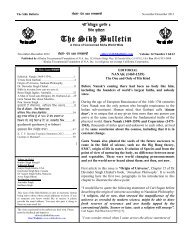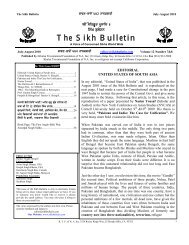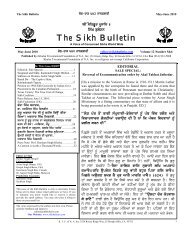hirmMdr ik drbwr swihb - The Sikh Bulletin
hirmMdr ik drbwr swihb - The Sikh Bulletin
hirmMdr ik drbwr swihb - The Sikh Bulletin
Create successful ePaper yourself
Turn your PDF publications into a flip-book with our unique Google optimized e-Paper software.
<strong>The</strong> S<strong>ik</strong>h <strong>Bulletin</strong> mwG-Pgx 542 nwnkSwhI January-February 2011<br />
mandirs devoted to Shiv. But Bhrama is worthy of<br />
being ignored altogether because creation (birth) has<br />
already taken place! So why bother with placating the<br />
God of creation. But if viewed deeper, such practicality<br />
is rooted within philosophical underpinnings of a trinity<br />
that is autonomous and sovereign in its origin as well as<br />
all major aspects of Hindu spirituality – including<br />
everyday spirituality as evidenced from the mandir<br />
proportions above.<br />
<strong>The</strong> root belief of S<strong>ik</strong>hism on the other hand is rooted<br />
in the unity of God. In the mool mantar – a list of<br />
attributes of God – the first attribute Ek Oangkar<br />
denotes his numerical as well as functional unity. In<br />
Japji Guru Nanak says of the trinity: Eka Maee Jugat<br />
Viayee, Tin Cheley Parvaan. Ek Sansari Ek Bhandari<br />
Ek Laye Deebaan. <strong>The</strong> use of the word “parvaan”<br />
denotes the accepted belief of trinity of the creator of<br />
the world (sansari), sustainer (bhandari) and destroyer<br />
(deebaan). Guru Nanak makes clear that the source of<br />
the power of creation, sustenance and destruction is<br />
one and more importantly, not with the trinity but<br />
elsewhere – Eka Mayee. <strong>The</strong> accepted trinity is the<br />
three children of the one mother Creator. It is the<br />
mother who creates her children, not the other way<br />
around.<br />
Guru Nanak thus deconstructs the notion that each<br />
portion of the trinity is supreme. Supremacy is to the<br />
Higher Creator who created these powers. Guru Nanak<br />
further deconstructs the notion that the trinity is<br />
autonomous, separate and sovereign – by use of the<br />
word “Cheley” for the trinity – they are followers of the<br />
Command and subject to the command themselves, but<br />
not masters. As followers, the origin of their powers is<br />
not self-derived. In pauree 26 Guru Nanak describes<br />
Bhrama as singing the praises of the Supreme Creator –<br />
Gavan Tudhno Esar Bhrama Devi. This verse<br />
underlines the master – chela relationship: it is the<br />
chela who sings praises of the master, never the other<br />
way around. In pauree 35 of Japji, Guru Nanak says,<br />
“Ketey Bhrama Ghaarat Ghraeeay, Roop Rang Key<br />
Ves” <strong>The</strong> creator has created countless Bhramas. In<br />
essence, then Guru Nanak is deconstructing the notion<br />
of Bhrama being the single creator. Instead, Guru<br />
Nanak is saying that the Single Creator created a<br />
multitude of other creators of various types and forms<br />
of which Bhrama is but one. So because God can create<br />
a million Bhramas, and Bhrama cannot create a single<br />
God, it is clear as to who the ultimate creator is.<br />
Within the 1430 pages of the GGS, Bhrama, Vishnu,<br />
and Shiv are mentioned countless times in a variety of<br />
aspects – but always as creation. For instance Bhagat<br />
Kabir asks rhetorically on page 331 of the GGS<br />
Jhagra Ek Niberho Raam (Kindly settle this dispute,<br />
God). Bhrama Bda Kay Jaas Upaiya (Is Bhrama larger<br />
than that that created him?). Again on page 441:<br />
Sarpnei Tay Upar Nahi Baliya. Jin Bhrama Bishen<br />
Mahesh Chaleya – None is beyond the worldliness of<br />
maya. Even Bhrama, Vishnu and Shiv got deceived<br />
into it. Guru Nanak says on page GGS 227: Prithmay<br />
Bhrma Kaley Ghar Aiya – and (just l<strong>ik</strong>e the rest of<br />
creation) Bhrama entered the house of death. On Page<br />
231 GGS Guru Amar Das writes: Bhrama Mool Ved<br />
Abhiasa – Bhrama is the founder of the study of<br />
Vedas. On page 359 of the GGS Guru Arjun writes:<br />
Paye Thagauli Sabh Jag Moheya. Bhrama Bishen<br />
Mahadeo Moheya – Maya has bewitched Bhrama,<br />
Vishu and Shiv.<br />
<strong>The</strong> sum total of such mentions provide us with the<br />
most fundamental, most basic and most primary<br />
difference between S<strong>ik</strong>hi and Hinduism – namely that<br />
in Hindu spirituality Bhrama is the one creator, while<br />
in S<strong>ik</strong>hism Bhrama is part of the multitude of God’s<br />
unlimited creation and subject to the laws of<br />
creation such as worldliness, maya and death. In S<strong>ik</strong>hi<br />
therefore, the Hindu god of creation was not beyond<br />
creation himself. In Hinduism, Shiv is the primary<br />
God of death, but in S<strong>ik</strong>hism Shiv was subject to death<br />
himself. Only the Eka Mayee is above birth, death and<br />
everything in between – hence Akaal Moorat<br />
(timeless), Ajooni (beyond life) and Saibhang (beyond<br />
creation) are basic S<strong>ik</strong>h descriptions of God. <strong>The</strong><br />
difference between Hinduism and S<strong>ik</strong>hism on the<br />
notion of God is thus fundamental and as immense<br />
as it can be between the Creator and creation.<br />
What about the belief regarding creation itself? <strong>The</strong><br />
root Hindu belief is that this creation is a myth.<br />
Creation is unreal in Hinduism. It is an illusion.<br />
S<strong>ik</strong>hism’s position is that the creation is not only real,<br />
but that God resides within His creation. Because God<br />
– a real entiry - resides within His entire creation, the<br />
latter cannot be an illusion. <strong>The</strong> term “Karta Purakh”<br />
in the mool mantar depicts such a position. He is not<br />
just a Creator, but a Creator Being. Creator Being<br />
means He is the essence of all that is created. He<br />
creates all and resides within all as the soul of creation.<br />
On page 83 of the GGS, Guru Nanak says Kudrat Kar<br />
K. T. F. of N. A. Inc. 3524 Rocky Ridge Way, El Dorado Hills, CA. 95762 7

















